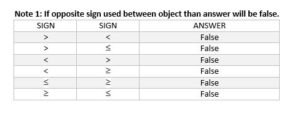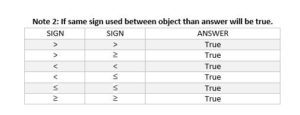How to Solve Reasoning Inequality Tricks & Shortcut Tips
Inequality in Reasoning Short-Cut Tricks & Tips : Inequality Tricks, Inequality in Reasoning Short-Cut Tricks & Tips Question Pdf for Banking, SSC, RRB, FCI, Railway, UPSC, State PCS, Insurance & other Competitive exams. Inequality in Reasoning Short-Cut Tricks & Tips shortcut Tricks Pdf, Inequality in Reasoning Short-Cut Tricks & Tips MCQ.
Inequality in Reasoning Short-Cut Tricks & Tips Objective Question & Answer Pdf. “Inequality in Reasoning Short-Cut Tricks & Tips Questions PDF” In this post we are providing you the Inequality in Reasoning Short-Cut Tricks & Tips pdf with detailed solution & Short Tricks. So that you can easily get the logic of question. This Inequality in Reasoning Short-Cut Tricks & Tips Pdf we are Providing is free to download. ” Most Important Inequality in Reasoning Short-Cut Tricks & Tips Question PDF with Answers“
Inequality in Reasoning Short-Cut Tricks & Tips Plays a vital role in Exam. In every exam you will get at least 3-4 questions from this topic. So candidates must focus on this topic and download this Inequality in Reasoning Short-Cut Tricks & Tips pdf to get important questions with best solution regarding Inequality in Reasoning Short-Cut Tricks & Tips. We have put all Previous Year Questions of Inequality in Reasoning Short-Cut Tricks & Tips that are Asked in various Govt & Private Exam.
Inequality Tricks
In inequality problems, each problem will have a statement followed by conclusions. We can easily score 4-5 marks from this topic in few minutes. Inequality is common topic for all competitive exams.
So, let’s learn this topic.
| Symbol | Meaning |
| > | Greater |
| < | Less |
| = | Equal |
| ≥ | Greater or equal |
| ≤ | Less or equal |
| ≠ | Not Equal / Either greater or less |
RULES:
“>” (more than) & “≥” (more than equal to) symbol explanation:
If the conclusion contains “>” (more than) symbol:
- It will satisfies if, “>” (more than) symbol present in the statement between objects.
- It will also follow “= (equal to)”, “≥ (more than equal to)” symbols but “> (more than)” symbol must be present at least in statement between the objects as per the conclusion.
If the conclusion contains “≥” (more than equal to) symbol:
- It will satisfies if, “≥” (more than equal to) symbol present in the statement between objects.
- It will also follow “= (equal to)” symbol, but “≥ (more than equal to)” symbol must be present at least in statement between the objects as per the conclusion.
Note: if the statement contains “≥ (more than equal to)” symbol, and conclusion has “= (equal to)” & “>” (more than) symbol, in this case either option will come into existence.

“<” (less than) & “≤” (less than equal to) symbol explanation:
If the conclusion contains “<” (less than) symbol:
- It will satisfies if, “<” (less than) symbol present in the statement between objects.
- It will also follow “= (equal to)”, “≤ (less than equal to)” symbols but “< (less than)” symbol must be present at least in statement between the objects as per the conclusion.
If the conclusion contains “≤” (less than equal to) symbol:
- It will satisfies if, “≤” (less than equal to) symbol present in the statement between objects.
- It will also follow “= (equal to)” symbol, but “≤ (less than equal to)” symbol must be present at least in statement between the objects as per the conclusion.
Note: if the statement contains “≤ (less than equal to)” symbol, and conclusion has “= (equal to)” & “<” (less than) symbol, in this case either option will come into existence.

Important Points :-

Example 1:
Statement:
P < Q > R < S > T
Conclusion:

Explanation: Sign used in statement as compared to conclusions are opposite, so the conclusion will be false.
Example 2:
Statement:
P ≥ Q ≤ R ≥ S ≤ T
Conclusion:

Explanation: Sign used in statement as compared to conclusions are opposite, so the conclusion will be false.

Example 3:
Statement:
P ≤ Q ≤ R ≤ S ≤ T
Conclusion:

Explanation: Sign used in statement as compared to conclusions are SAME, so the conclusion will be TRUE.
Important conclusion Based on Statement
| S.No | Statement | Conclusion |
| 1. | A > B > C | A > C |
| 2. | A > B ≥ C | |
| 3. | A ≥ B > C | |
| 4. | A = B > C | |
| 5. | A > B = C | |
| 6. | A <B < C | A < C |
| 7. | A < B ≤ C | |
| 8. | A ≤ B< C | |
| 9. | A = B < C | |
| 10. | A < B = C | |
| 11. | A ≥ B ≥ C | A≥C(Either A>C or A=C) |
| 12. | A = B ≥ C | |
| 13. | A ≥ B = C | |
| 14. | A ≤ B ≤ C | A ≤ C (Either A < C or A = C) |
| 15. | A = B ≤ C | |
| 16. | A ≤ B = C | |
| 17. | A < B > C | Either 1 or 2 follows if any of the following cases (a, b, c and d) are given as they form a complementary pair.
a) 1. A > C 2. A ≤ C b) 1. A ≥ C 2. A < C c) 1. A < C 2. A ≥ C d) 1. A ≤ C 2. A > C |
| 18. | A ≤ B> C | |
| 19. | A < B≥ C | |
| 20. | A > B < C | |
| 21. | A > B ≤ C | |
| 22. | A ≥ B < C |
Steps for Solving Problems
Step I: Decode the given symbols like @, $, d, #, *, etc.
Step II: Take one conclusion at a time and make an idea that which statements are relevant for evaluating it.
Step III: Use conditions I and II to combine the relevant statements and derive a conclusion from it. They are:
Condition I: There must be a common term.
Condition II: The common term must be less than or equal to one term and greater than or equal to another.
Practice Set for Inequality
Directions (1 – 5): In the following questions, the symbols %, @, #, $ and & are used with the following meaning as illustrated below:
‘P%Q’ means ‘P is neither smaller than nor equal to Q’.
‘P@Q’ means ‘P is neither greater than nor equal to Q’.
‘P#Q’ means ‘P is not greater than Q’.
‘P$Q’ means ‘P is not smaller than Q’.
‘P&Q’ means ‘P is neither smaller than nor greater than Q’.
Now in each of the following questions, assuming the given statements to be true, find which of the four conclusions I, II, and III given below them is/are definitely true and give your answer accordingly.
- Statements: Q%C, C$W, W&D, D@X
Conclusions:
I. C%D
II. W@Q
III. X%W
A) Only I
B) Only II
C) Both II and III
D)AllI, II and III
E) Only I and II - Statements: S&W, W#Q, Q%X, X$V
Conclusions:
I. Q&S
II. X%W
III. V@Q
A) Only II
B) Only I
C)Only I and III
D) Only III
E) None of these - Statements: A@W, W$E, E#S, S&J
Conclusions:
I. A$E
II. J&W
III. A@E
A) Either I or III
B) Only I
C) Only II and III
D) All I, II and III
E) Either I or III and II - Statements: A#B, X%B, R$X, R@S
Conclusions:
I. R%B
II. R$B
III. A@S
A)Both I and II
B) Both I and III
C) Both II and III
D) Either I or II and III
E) Only I - Statements: X$D, D%W, W&F, F@A
Conclusions:
I. A@W
II. X%F
III. D&A
A) Only III
B)Both I and II
C) All I, II and III
D) Both II and III
E) None of these
Direction (6-10): Relationship between different elements is shown in the statements. Find if the conclusions also follow or not.
- Statements: W > A ≤ G, S ≤ A, I ≤ B = S
Conclusions:
G ≥ I
G = I
A) only I follows
B) only II follows
C) either I or II follows
D) neither I nor II follow
E) both I and II follow - Statements: Q< W ≤ B, C> B < K, W ≥ A
Conclusions:
I. K > W
II. C> A
A) only I follows
B) only II follows
C) either I or II follows
D) neither I nor II follow
E) both I and II follow
- Statements: A > E ≥ F, P = E, S > A
Conclusions:
S> P
F < S
A) only I follows
B) only II follows
C) either I or II follows
D) neither I nor II follow
E) both I and II follow
- Statements: S ≥ W > K, W > F < A, P > S
Conclusions:
I. P >A
II. S> F
A) only I follows
B) only II follows
C) either I or II follows
D) neither I nor II follow
E) both I and II follow - Statements: R ≥ X ≥ S, S< C, C > W
Conclusions:
W> X
X ≥ W
A) only I follows
B) only II follows
C) either I or II follows
D) neither I nor II follow
E) both I and II follow
| Maths Topicwise Free PDF > Click Here To Download | English Topicwise Free PDF > Click Here To Download |
| GK/GS/GA Topicwise Free PDF > Click Here To Download | Reasoning Topicwise Free PDF > Click Here To Download |
| Banking Topicwise Free PDF > Click Here To Download | DI Topicwise Free PDF > Click Here To Download |
| All Subject Topicwise Short Tricks > Click Here To Download | Static GK & Awareness Topicwise Free PDF > Click Here To Download |
| Please Support us by Joining Below Groups & Like Our Pages we will be very thankful to you. | |
| Facebook Page : https://www.facebook.com/governmentadda/ | |
| Facebook Group : https://www.facebook.com/groups/governmentadda/ | |
| Telegram | Official Channel : https://telegram.me/GovtAdda |
| Current Affairs Channel : https://telegram.me/Ga_Buzz | |
| UPSC Channel : https://telegram.me/CivilServicesAdda | |
| SSC Channel : https://telegram.me/SscAdda | |
| Banking Channel : https://telegram.me/IbpsZone | |
| RBI Group : https://telegram.me/RbiZone | |
| Railway RRB Channel : https://telegram.me/RailwayZone | |
| IT Officer Group : https://telegram.me/IT_Officer | |
| Insurance Group : https://telegram.me/InsuranceZone | |
| Job Alert Channel : https://telegram.me/JobAlert | |
| https://twitter.com/GovtAdda | |
| https://www.instagram.com/governmentadda/ | |
| https://www.pinterest.com/governmentadda/ | |
| Youtube | Click Here To Subscribe Now |
Thanks,
Team GovernmentAdda
Share & Support Us









